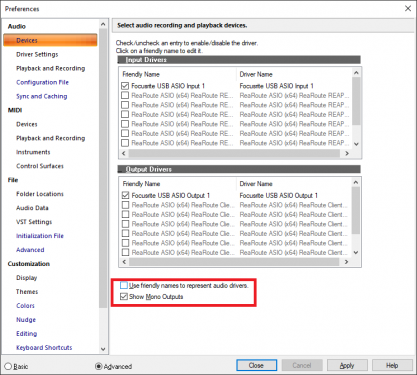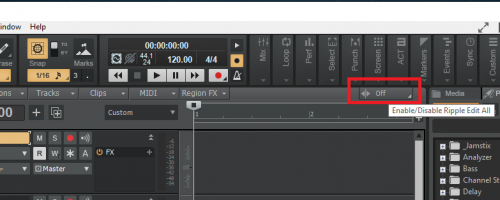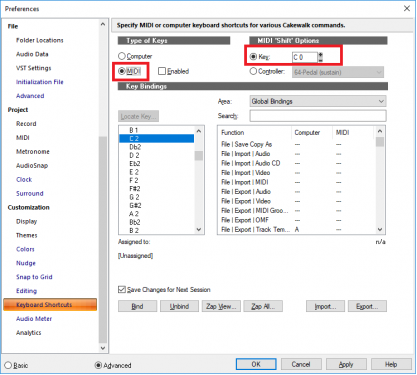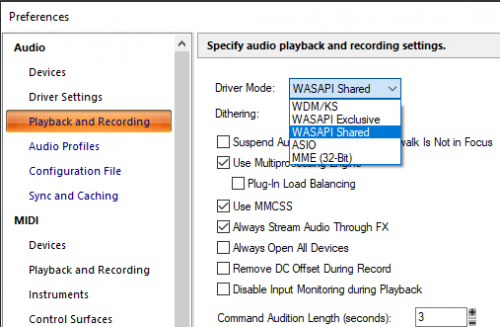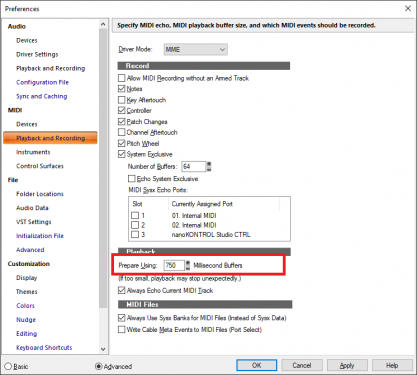-
Posts
7,119 -
Joined
-
Last visited
-
Days Won
39
Everything posted by msmcleod
-
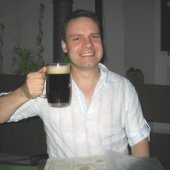
Need help directing input and output drivers in Cakewalk
msmcleod replied to Kenny Burch's question in Q&A
UMC1820 inputs Channel 1 = Left UMC1820 ASIO Driver In 1 Channel 2 = Right UMC1820 ASIO Driver In 1 Channel 3 = Left UMC1820 ASIO Driver In 3 Channel 4 = Right UMC1820 ASIO Driver In 3 Channel 5 = Left UMC1820 ASIO Driver In 5 Channel 6 = Right UMC1820 ASIO Driver In 5 Channel 7 = Left UMC1820 ASIO Driver In 7 Channel 8 = Right UMC1820 ASIO Driver In 7 ADA8200 inputs: Channel 1 = Left UMC ASIO Driver ADAT 1 Channel 2 = Right UMC ASIO Driver ADAT 1 Channel 3 = Left UMC ASIO Driver ADAT 3 Channel 4 = Right UMC ASIO Driver ADAT 3 Channel 5 = Left UMC ASIO Driver ADAT 5 Channel 6 = Right UMC ASIO Driver ADAT 5 Channel 7 = Left UMC ASIO Driver ADAT 7 Channel 8 = Right UMC ASIO Driver ADAT 7 These names are what the driver is presenting to Cakewalk. If they're confusing, enable the "Use friendly names to represent audio drivers" checkbox, and double click/edit the friendly name to what you want. -

CAL or Key control move now time to next midi note?
msmcleod replied to sadicus's topic in Cakewalk by BandLab
Iterating through MIDI notes is the mainstream of what CAL does. Normally you'd use the forEachEvent loop to go through MIDI events, however there's a gotcha in that you can't manipulate Markers or the now time within that loop.... so you'll need to get creative to get around that. You could probably nest a forEachEvent loop inside another loop, which breaks out every time it finds a note; create the marker, then run the loop again skipping the one's you've already seen. Also, if you want this to work across all tracks, it's gonna get complicated... but not impossible. -

Need help directing input and output drivers in Cakewalk
msmcleod replied to Kenny Burch's question in Q&A
You need to enable "Show Mono Outputs" within your device settings: With this checked, you'll now see Left, Right & Stereo for each stereo pair. -

[ SOLVED ] - How to record MIDI arp realtime
msmcleod replied to sadicus's topic in Cakewalk by BandLab
As far as I know, the only thing that will save patterns into arp files is Project 5, which is sadly discontinued. -
This is currently being discussed in a couple of threads at the moment: There's two workarounds: 1. Increase your ASIO buffer; or 2. Try O'Deus ASIOLink instead of ASIO4ALL - this adds no extra latency:
-
I've found this too. Cakewalk is pretty quick at detecting a MIDI device being removed, but doesn't always pick up new MIDI devices being added. I had this yesterday when trying to sample an old MT-32 using my old laptop and swapping out various MIDI devices (to be fair, in this instance I was using Sonar 8.5... but I've had the same in CbB). As it stands the only reliable way of getting an updated list of MIDI devices is to restart Cakewalk. A "Refresh" button on the MIDI Devices preferences pages would be really helpful.
-
Probably less expensive than BandLab paying the bakers $10,000's over the next 6 months to develop one from scratch. Just use this: https://www.tx16wx.com/ - it's free for the basic version, and only €39 for the extra features should you need them.
-
Sforzando is free. AFAIK you need the full (paid) version of Kontakt to play your own SFZ files. Also, I've found Kontakt to be quite processor intensive compared to other players. This is fine if I'm already using Kontakt for other sounds, and just want to add another instrument. But it wouldn't be my go to player for a single track for this reason.
-
-
You need to use the Comp clip to drag to include the automation lanes, rather than selecting an individual clip:
-
For those interested in using CAL, here's a link to a comprehensive guide: http://members.ziggo.nl/t.valkenburgh/Cakewalk Application Language Programming Guide.pdf
-

Control Surface compatibility
msmcleod replied to Studio Brasil Producer's topic in Cakewalk by BandLab
If you're using the Behringer X-Touch, you should set it to Mackie Control mode and use the Mackie Control control surface, not ACT: You may also want to look into getting a lexan overlay for the x-touch, so that it matches the corresponding MCU lexan overlay for SONAR: https://store.birchwoodstudioandevents.com/Sonar-Overlay -

[CLOSED] Cakewalk 2019.07 Early Access 1
msmcleod replied to Jesse Jost's topic in Early Access Program
I've just spent the last hour messing around with various settings. One post on the Avid forum suggested it was Intel Turbo Boost causing it, but disabling it in the BIOS makes no difference for me. I can usually make this happen reliably by quickly stopping/starting the transport repeatedly. It'll happen around 1 out of 5 times doing this when my usual ASIO buffer setting of 64. When it's set to 32, I get it 2 out of 3 times. Obviously in normal use, it's a lot less frequent than this - I quite often use a buffer setting of 32 for recording piano, and I can go several hours with it happening only once or twice in normal use. However, I failed to get the motor-boating with a buffer of 128 or higher. So I think the answer is to use a larger ASIO buffer, and if necessary use the PDC button when tracking. If you really need to use a lower buffer, then just accept the buzz might come along now and again. [Edit] - It's worth mentioning I've only ever heard of this happening with the Scarlett interfaces. I certainly don't get this with any of my other interfaces. -

[CLOSED] Cakewalk 2019.07 Early Access 1
msmcleod replied to Jesse Jost's topic in Early Access Program
FWIW, I get this on my 6i6 and my 18i20 - both are 1st gen, although it doesn't happen often enough to cause me an issue. More often than not stopping & starting the transport fixes it, and if that doesn't work restarting the audio engine always fixes it. A couple of things I've noticed: It happens more often on lower ASIO buffer settings I've never seen it happen when the 6i6 / 18i20 ASIO drivers are wrapped up with ASIOLink, and CbB is using the ASIOLink drivers. This leads me to believe that it's either a timing issue and/or something to do with the order of the calls to the ASIO driver. -
I've not had a huge amount of experience with Samsung SSD's, but quality-wise I they're probably on par - at least for the evo/pro range vs the crucial MX range. This deal is for the QVO series though... which is their budget range. It's more akin to the Crucial BX series than the Crucial MX series. Personally, I wouldn't go for these ones. For the same price you an get a CrucialMX500 1TB, which is a much better drive.
-

Emulating Favorite Hardware Patches
msmcleod replied to Sleetah2000's topic in Instruments & Effects
@Sleetah2000 - apologies for the long delay on this. Things have been really hectic lately. Here it is: http://msmcleod.co.uk/cakewalk/Synthbass3.zip -

BUG - ProChannel Console Emulator Channel
msmcleod replied to Sarah Rosen's topic in Cakewalk by BandLab
This sounds a strange one. I'm definitely not seeing it - I use the console emulator on the ProChannel on most tracks, and in some cases I have more than one console emulator on the same track. Do you get this on every project? -

[Solved] How can I assign music keyboard keys to operate transport?
msmcleod replied to Keni's topic in Cakewalk by BandLab
You can do it in Keyboard Shortcut preferences: Of course you can use ACT as well, but this may be easier to set up. -
I think these plugins by Leslie Sandford deserve a mention: Cobalt - a VSTi reminiscent of the Korg DW8000 & Kawai K5 Sandford Delay - tempo based delay effect Sanford Reverb - a no-nonsense reverb, with pretty low CPU usage Bass Tightner - a spatial effect for tightening up the stereo spread. https://www.lesliesanford.com/vst/plugins/
-
I've had this happen to me before, when I try to use melodyne immediately after editing a clip. The workaround was to do "bounce to clip(s)" on the clip before creating the region fx.
-
Were the original projects created with a much earlier version of Melodyne? This could be the problem. You could try renaming the Melodyne subdirectory within your project's folder. This may prevent Cakewalk trying to load it.
-

Audio Render error when new project opened
msmcleod replied to Ram Chebiyyam's topic in Cakewalk by BandLab
Actually, there's two other options I totally forgot about. WDM is a much better alternative to MME, and will give you much better latency. Another thing you could try is ASIO4All, which basically wraps the WDM driver up as an ASIO driver. You may get much better performance using this method. http://www.asio4all.org/ -

Audio Render error when new project opened
msmcleod replied to Ram Chebiyyam's topic in Cakewalk by BandLab
First of all, I'd make sure that the sample rate / bit depth within Windows matches what you've got in Cakewalk. Windows quite often defaults to 48Khz / 16 bit, whereas many Cakewalk users prefer 44.1Hkz/ 24 bit. Pick one you want to use, and make sure both Windows & Cakewalk are using the same settings. If this doesn't work, what audio driver mode have you got set within preferences? If you've got it set to ASIO, then consider one of the WASAPI modes. The ASIO drivers for on board devices are notoriously bad. If you've got it set to WASAPI (Exclusive), Cakewalk may be having trouble "stealing" the audio device from your browser running YouTube. If this is the case, try setting it to WASAPI (Shared). If you've already got it set to WASAPI (Shared), it might be that your audio device doesn't support sharing. If this is the case you could try setting it to WASAPI (Exclusive), or MME. Be aware though that MME can have pretty high latency, so this may cause problems when recording software instruments in real time. By far the best solution is to buy a dedicated external ASIO audio interface, though I appreciate this might not be an option for you. -

Addictive Drums 2 cymbal crashes velocity problems
msmcleod replied to Jeremy Jensen's topic in Cakewalk by BandLab



